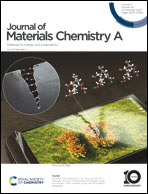UiO-66 metal–organic framework-derived ZrO2/ZnO mesoporous materials for high-efficiency detection of NO2 at room temperature†
Abstract
To overcome the drawbacks of low sensitivity and limited selectivity exhibited by metal oxide sensitive materials, a metal–organic framework (MOF) derived composite (marked as UZZ) was constructed via a combined wet chemical method. UiO-66 was used as the precursor with the introduction of ZnO. The ZrO2 component in UZZ retains the unique octahedral configuration of UiO-66; on its folded surface, a large number of ZnO particles grow, whose sizes range from 20 to 40 nm. The composite exhibits excellent gas sensitivity to NO2 at room temperature. Exemplarily, the gas sensitive response to 100 ppm NO2 is 40.35, with a response time of 1.4 s and a detection limit as low as the 50 ppb level, and the stability is up to 8 weeks. The presence of numerous oxygen vacancies and n–n type heterojunctions on the surface of the UZZ composite synergistically enhances the gas-sensing performance. This finding provides a significant reference for developing new efficient and high-sensitivity metal oxide sensitive materials based on MOFs.



 Please wait while we load your content...
Please wait while we load your content...